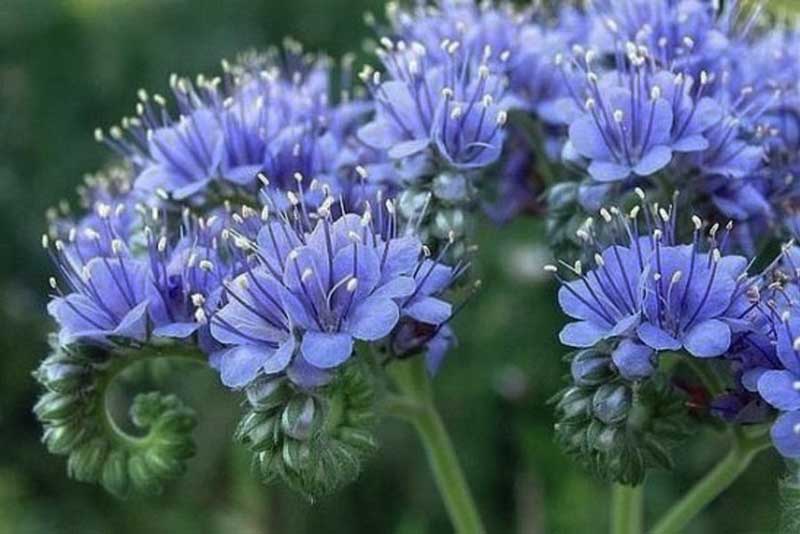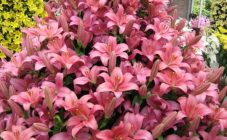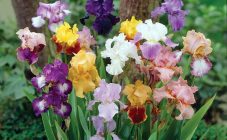Content:
Phacelia is a plant that belongs to melliferous plants. The flower grows only one year from the moment of sowing. The honey that bees collect from the plant is very tasty and has a lot of useful qualities. From a hectare of area where flowers for phacelia bees grow, under favorable conditions, at least six centners of the product are harvested.
Description and characteristics of the plant
For beekeepers, phacelia is of value for its unpretentious cultivation. In addition, the plant blooms for a long time and constantly produces nectar, even after sunset. The plant belongs to the annual grasses of the Aquiformes family. The grass came to Russia from America.
The stem grows up to a meter in height and has a large number of branches. The leaves have a pinnate dissection and are arranged in a regular order. The culture blooms with small flowers that have a grayish-bluish color. They are collected in inflorescences and have the shape of a bell.
Phacelia is completely picky about soil selection. It grows under any conditions. Can easily tolerate drought and changes in air temperature. In addition to being a honey plant, it is also referred to as phytosanitary. It is not affected by diseases or pests.
The benefits of phacelia include:
- the grass grows under any conditions and at any time of the year, except for winter;
- you can sow phacelia anywhere, it is unpretentious in the choice of soil;
- grows even in soil that is depleted by other plants;
- blooms and develops in rain and cold weather;
- grows and develops rapidly;
- has a lot of greenery;
- due to its ability to quickly decompose in the soil, it acts as a fertilizer rich in nitrogen.
Based on the advantages of the plant, it can be safely considered ideal.
There are over eighty varieties of phacelia that are used by humans for the following purposes:
- as green manure and mineral fertilizer;
- to obtain high-quality natural honey;
- for decorating flower beds as an ornamental plant;
- as animal feed.
As a siderate, phacelia performs the following actions:
- fertilizes the soil, acting as an organic fertilizer;
- loosens the soil, which after this plant becomes fluffy;
- structures;
- the soil is saturated with oxygen in full;
- clears the soil from weeds, dulling their growth;
- eliminates pests and pathogens of plant diseases;
- neutralizes soil acidity;
- by the aromas exuded, the plant attracts beneficial insects;
- the plant is very fond of bees;
- if the culture is left for the winter, then it will retain moisture, will not allow it to freeze too much;
- the sprouted grass protects the soil from drought, retaining moisture in it.
Thanks to the large amount of nutrients contained in the greens, the crop is an excellent feed for livestock. Animals not only gain weight quickly, but also do not get sick.
As a honeybee plant, phacelia is highly valued by beekeepers. Bees make a very tasty and healthy product from its nectar.
Summer residents fell in love with this plant for its ability to decorate their personal plot.
It is ideal for decorating:
- flower beds,
- root zone of trees,
- berry bushes,
- beds.
A plant sown in a flowerpot can be decorated with:
- gazebos,
- open terraces,
- the porch of the house.
In the garden, you can create decorative alpine slides and decorate them with phacelia. Low-growing varieties will look great between stones. Tall varieties are suitable for decorating beds, a garden plot in the background.
When to sow phacelia for bees
Every beekeeper knows: to get a good harvest of honey from bees, you need an excellent honey base. Now in villages, household plots are empty and overgrown with weeds, which do not bring any benefit to the bees. These plots can be used by beekeepers to increase the honey area. The best honey plant is phacelia for bees, when many beekeepers are interested in sowing it.
In addition, you can sow:
- sweet clover,
- winter rapeseed,
- oil radish,
- mustard,
- oriental goat's rue,
- oregano,
- melissa,
- catnip,
- motherwort,
- hyssop,
- cucumber grass.
This plant is sown in two stages, thus increasing its flowering period. First, the seeds are sown in the ground in the last days of April - early May, the second stage begins in the second half of May. With this sowing, the flowering period of the plant will end at the end of August.
Why bees don't go to phacelia
Phacelia should be sown early, so it will start blooming in early July. These times are ideal for bees to collect honey. If the culture is sown much later, then it will begin to bloom, respectively, later. The flowering period will fall at a time when daylight hours are significantly reduced and the air is cold. Thus, the bees will not be able to collect nectar as preparations for wintering will begin.
How to grow phacelia
Phacelia is beginning to gain more and more popularity among beekeepers and people keeping cattle, as it is, first of all, an excellent honey plant and good animal feed. Those gardeners who are not yet familiar with a plant such as phacelia want to know how to sow a crop correctly.
You can sow the crop throughout the season. She calmly tolerates severe cold, and even a frost of minus nine degrees will not harm the plant. For this reason, seeds can be sown immediately after the snow melts. For one hundredth of the area, you need to consume no more than ten grams of seeds. Phacelia begins to bloom after four, or even six weeks.
If the phacelia melliferous herb is sown into the soil as a green manure, then in this case the first sowing must be mowed and plowed. The bottom layer will rise to the surface, and the green mass will serve as fertilizer. At this time, a secondary sowing of the plant is done. The second time the plant is mown when flowering in mid-August. The mass is again mixed with the soil. In this way, the gardener gets fertile soil in the fall, in which he can safely sow winter crops.
Many are interested in: is it possible to plant phacelia in the fall. If sowing is done immediately after the crop has been harvested, then the plant will still have time to bloom before the first frost. This way you can prepare the soil for spring work and planting vegetables. The soil will be fertilized and fertile.
Phacelia can be used as a protection for other vegetables.After sowing a plant in early spring, crops such as tomatoes or cucumbers can be planted in its thickets. Thus, thanks to the substances that the culture secretes, vegetables are disinfected and do not get sick. Also, the plant will serve as protection against pests.
The phacelia melliferous plant, in all its positive qualities, is an ideal plant that can be used for various purposes. At the same time, culture does not require any special care for itself.
















